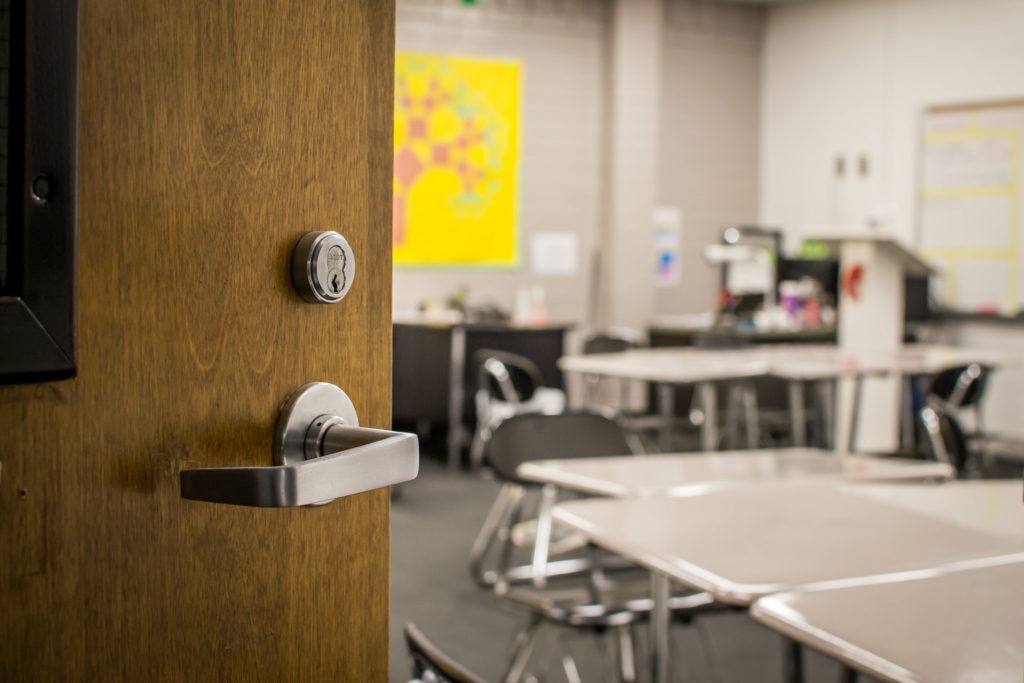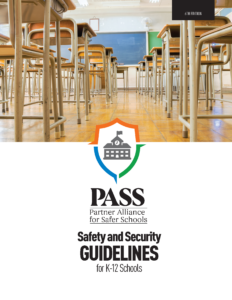More Secure, Less Convenient: The Debate on Classroom Door Locks
Given today’s school climate, locking classroom doors may seem like an obvious protocol for teachers. However, sentiment surrounding classroom door locks has changed drastically over the last 20 years. Learn more about the debate surrounding classroom door locks and how, when used properly, these tiny devices continue to keep our schools safe and secure.
Uniformity Saves Lives
Have you ever noticed that, whether you enter a bank, library or rec center, all doors function the same way? Probably not. If doors are the last thing on your mind whenever you enter a building it may be because those doors and how they operate—whether in a classroom or any building in the country—are a matter of federal regulation.
Ken Cook, Director of National School Safety and Advocacy with Allegion, puts it this way: “If you’re in a building today, and you need to get out, all you need to do is look for the exit. That’s by design.”
History is full of examples of human loss—people who were unable to flee or evacuate a building quickly and easily. Thus, fire and building codes were created to standardize doors and exits so you don’t have to use extra mental energy when seconds matter most.
Classroom Door Locks: What’s the Big Deal?
The act of locking classroom doors has received a lot of scrutiny over the past few decades. In the early 2000s, public opinion was largely against it. Some critics equated it to locking the front doors of a church. In fact, classroom doors on Virginia Tech’s campus were lockless during the tragic campus shooting on April 16, 2007.
A Brief History of Classroom Door Locks
Devising the perfect classroom lock has been, as Cook said, “a balancing act.” Teachers needed to be able to lock their classroom doors: (1) quickly and easily; (2) without inviting student tampering; and (preferably) (3) without needing a key or other tool present.
When schools first started implementing classroom door locks, Cook explained, they used so-called “office function locks,” which locked from inside the room with the push of a button. As any parent could guess, this setup led to mischievous students locking their teachers out of the room. So what is known as the traditional classroom lock was developed, which can only be locked with a key. It also can only be locked from outside the classroom.
However, after the Columbine school shooting in 1999, it became clear that requiring teachers to open a classroom door in order to lock it was no longer a safe option.
Finally, a solution: the classroom security function lock was developed. With this lock, a key on either side of the door could lock the outside lever while the inside lever remains unlocked. This lock allows free exit from the room at any time while also keeping locking power in the hands of authorized personnel. While still requiring a key, this lock successfully met the first two criteria.

Classroom Door Locks Checklist
In the aftermath of the Sandy Hook tragedy in 2012, the Sandy Hook Advisory Commission recommended in its final report that all classrooms have doors that can be locked from the inside.
“The Commission cannot emphasize enough the importance of this recommendation,” its report stated. “The testimony and other evidence presented to the Commission reveals that there has never been an event in which an active shooter breached a locked classroom door.”
The report did not dictate specifically which locks schools should use, allowing schools the flexibility to decide. The National Association of State Fire Marshals published a checklist to help schools ensure their classroom doors remain as secure as possible, including recommendations such as:
- A door should be lockable from inside the classroom without requiring the door to be opened;
- Exiting a classroom should be possible without a key or other tool, special knowledge, or effort;
- To exit a room, unlatching the door should be possible with one hand;
- A classroom door should be lockable and unlockable from outside the classroom; and
- The handle should be operable without tight grasping, pinching, or twisting of the wrist.
Balancing Safety and Security with Convenience
Getting schools the right equipment is just the first step; implementation through robust school policies is equally important. All too often, teachers aren’t consistent about locking their own classroom doors, even with the appropriate hardware. This is because getting up to let students in when they’re late or coming back from the bathroom becomes a distraction to students and teachers alike.
“You have to balance security, safety and accessibility along with convenience,” said Lori Greene, Codes and Resources Manager for Allegion. Greene regularly witnesses clashes between state and federal laws, safety codes, and school policies. For example, some schools have a policy allowing teachers to leave their doors pre-locked and then use a magnet to prevent the door from closing all the way. This allows for easy re-entry while also being quickly bypassed in the event of an emergency.
It’s also unfortunately against the fire safety code (if the classroom doors are fire-rated). And in at least one school shooting, the assailant removed the magnet and closed the locked door, preventing school staff from entering the classroom.
She’s also seen instances of schools with unsafe “DIY” practices every time there’s another school shooting, such as putting firehose tubing around door closer arms in an attempt to keep the door closed against a threat (also against the fire safety code and the Americans with Disabilities Act). “It’s time we bring everyone together to finally get this right,” Greene said. “We need to be prepared but not react with fear.”
Let’s Keep School Safety and Security Simple
This is one aspect of school safety and security that can stay simple. A modern classroom door lock has been proven to save lives in the face of active threats without compromising our kids’ safety by trapping them inside the classroom. For more information on classroom door security, as well as proven safety and security practices for your school, check out our PASS Guidelines and Safety and Security Checklist, available at no cost.
Contributors: PASS thanks Lori Greene, Ken Cook, and Allegion for the research used in this article.
Allegion creates peace of mind by pioneering safety and security. As a $2 billion provider of security solutions for homes and businesses, Allegion employs more than 8,000 people and sells products in more than 120 countries across the world. Allegion comprises 27 global brands, including strategic brands CISA®, Interflex®, LCN®, Schlage® and Von Duprin®.
The Partner Alliance for Safer Schools (PASS) is a nonprofit 501(c)(3) bringing together expertise from the education, public safety, and industry communities to develop and support a coordinated approach to making effective and appropriate decisions with respect to safety and security investments. You can download the complete PASS Guidelines on our website, or check out our PASS Safety and Security Checklist for quick tips on how to get started. These resources—as well as whitepapers on various topics including barricade devices, lockdown drills, and more—are available at no cost.
Categories
- Access Control
- Classroom Door Locks
- Crime Prevention Through Environmental Design
- Cybersecurity
- Duress Alarm
- In the News
- Legislation
- Lockdown Drills
- New Technologies
- PASS Advisory Council
- PASS Board of Directors
- PASS Partners
- PASS Recommendations
- Preparedness
- Safe School Week
- Safety & Security Guidelines
- School Safety & Security
- Security Best Practices
- Video Surveillance

Ready to get the Guidelines?
The most comprehensive information available on best practices specifically for securing school facilities, vetted extensively by experts across the education, public safety and industry sectors.
